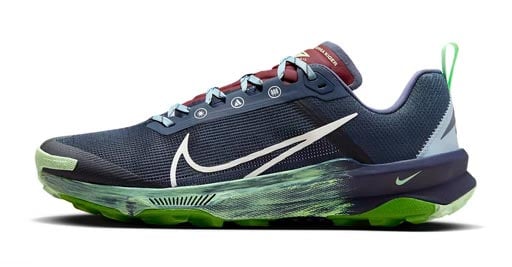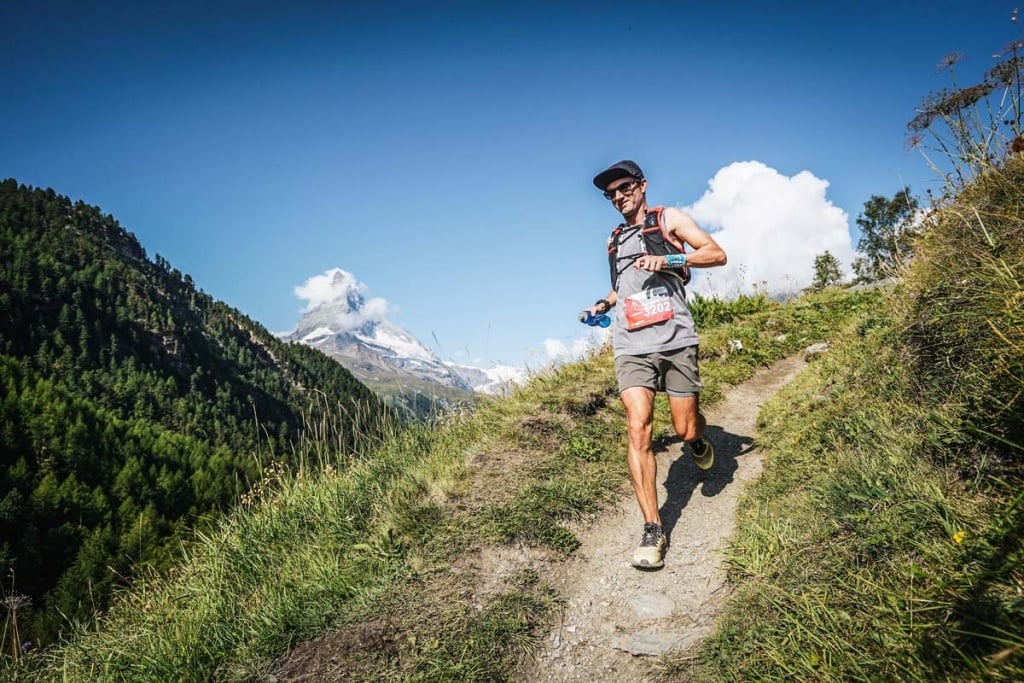If you’re new to off road running and wondering how to start trail running including what you need to know before you go off and run a trail for the first time, then you’ve come to the right place!
This beginner’s guide shares everything you need to know, including how to start trail running, techniques, important tips to help you improve (and run safely), the best trail running gear, and information like how to find local trails to run on.
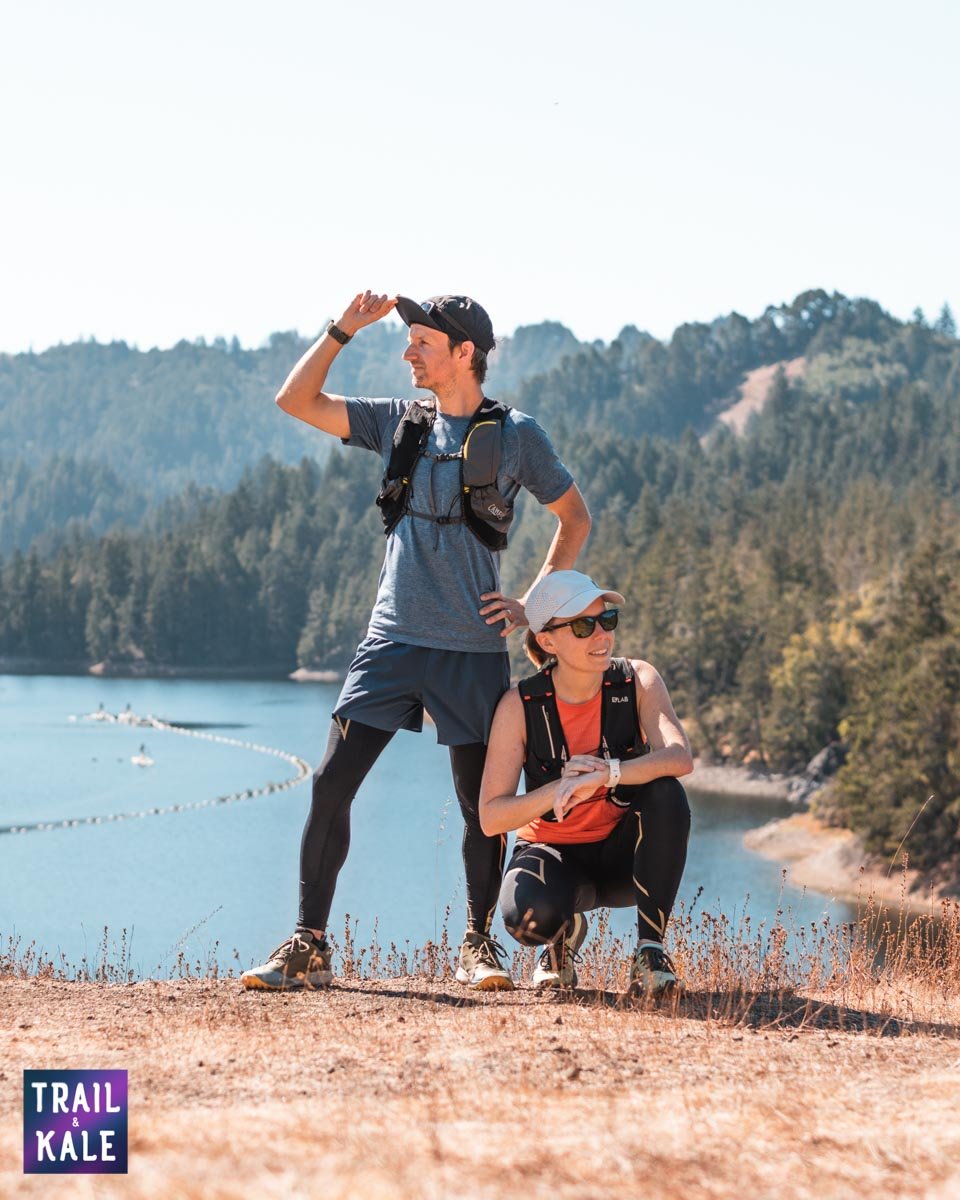
We’ll start by answering the first questions most people have and sharing all you need to know about the basics of how to trail run when it comes to finding trails, pacing yourself, and techniques, to ensure you have an enjoyable time on the trails – and more importantly to make sure you finish your run wanting more.
Good trail running shoes are obviously one of the most important things to get right when you start trail running, and we are lucky enough to be able to review all the latest trail running gear for a living, and as a result, know what works and what doesn’t.
This post is sponsored by Nike – thank you for helping us create original content just like this! Here are our top Nike trail running shoe recommendations based on our review testing:
★ For all terrain: The Nike Terra Kiger 9 – for the runner who wants a pair of trail running shoes that can do it all. The Terra Kiger can tackle technical trails and will keep up with your progress as you improve as a trail runner.
★ For technical trails: The Nike Zegama – designed for running in rocky, steep and altogether gnarly and hilly or mountainous terrain, the Nike Zegama is a great choice if your chosen trail running environment is more technical than the local park singletrack and fire roads frequented by most.
★ For light trails and new trail runners: The Pegasus Trail 4 – for the beginner who is excited to experience light trails for the first time but also needs a comfortable shoe that performs very well on hard road surfaces. This door-to-trail shoe is a very versatile option if you don’t want to buy an extra pair of shoes just for trail running
This trail shoe is also available in a waterproof version, the Pegasus Trail 4 Gore-Tex, for cold and wet running conditions.
To learn more about the Nike Trail brand or to find the right Nike Trail running shoes for you, read our ‘Nike Trail Running Shoes Compared‘ buyer’s guide to find the best Nike Trail Running shoes for you.
Trail Running For Beginners – Table of Contents
- What is Trail Running?
- How to Trail Run: Tips and Technique Basics
- Gear Guide – Shoes, Apparel, and Accessories You Need
- How To Find Local Trails
- Other Tips and FAQs
- Glossary of Trail Running Terms
What Is Trail Running?
Trail running is primarily off-road running, such as running on dirt, single-track trails, fire roads, and forest trails.
It’s what mountain biking is to road cycling, in the cycling world.
Running trails can be as mellow as a 5k lap around your local city park or as extreme as a multi-day mountain running adventure across remote terrain or mountain passes.
👋🏼 If this is your first time on Trail & Kale, welcome! This site (and our YouTube channel) are designed to help you run your best, through our training plans, 101 run tips, and insightful, honest running shoe reviews, just like this one. Subscribe to our Newsletter to get full access to our Training Plans, and to stay up to date with all the latest running gear reviews.
Is Trail Running More Difficult Than Road Running?
If you’re new to running on trails but already have experience with regular road running on pavements or footpaths, then you may be wondering how it compares to road running and what the key differences are.
One of the most common questions we get asked is: ‘is trail running more difficult than road running?‘.
We tend to answer with a resounding Yes (with caveats) – in many ways, it is more difficult than road running.
BUT with that said, it can be as hard or easy as you want to make it.
While the motivation for some runners when running on roads is to improve speed and pace over a certain distance and work hard to beat PRs, the motivation for many trail runners can be very different.
Many people choose to run a trail rather than on pavement for the mental and physical benefits of trail running on softer, non-repetitive terrain, away from traffic and crowds of people.
Not to mention the pure joy of exercising in nature, the accomplishment of climbing hills and mountains, and of course the reward of a beautiful view at the end of it.
Some people choose not to wear a running GPS watch at all, and run for the pure pleasure of running, with no monitoring of their time, heart rate, or pace.
That’s not us, however, as we also run for health and fitness benefits, as well as being able to compete in trail races around the world.
The differences between these two styles of running are covered in more depth in this post: Trail Running VS Road Running.
How to trail run: Top tips and the basics you need to know
This section covers tips and the basics, including how to improve running form, how to pace yourself correctly, how to avoid falling over, and tips to help you run safely and efficiently.
What is a good trail running pace?
This is a commonly asked question by runners who already have experience running on pavement and are looking to get a feel for how fast paces are on trails when compared to their normal road running pace.
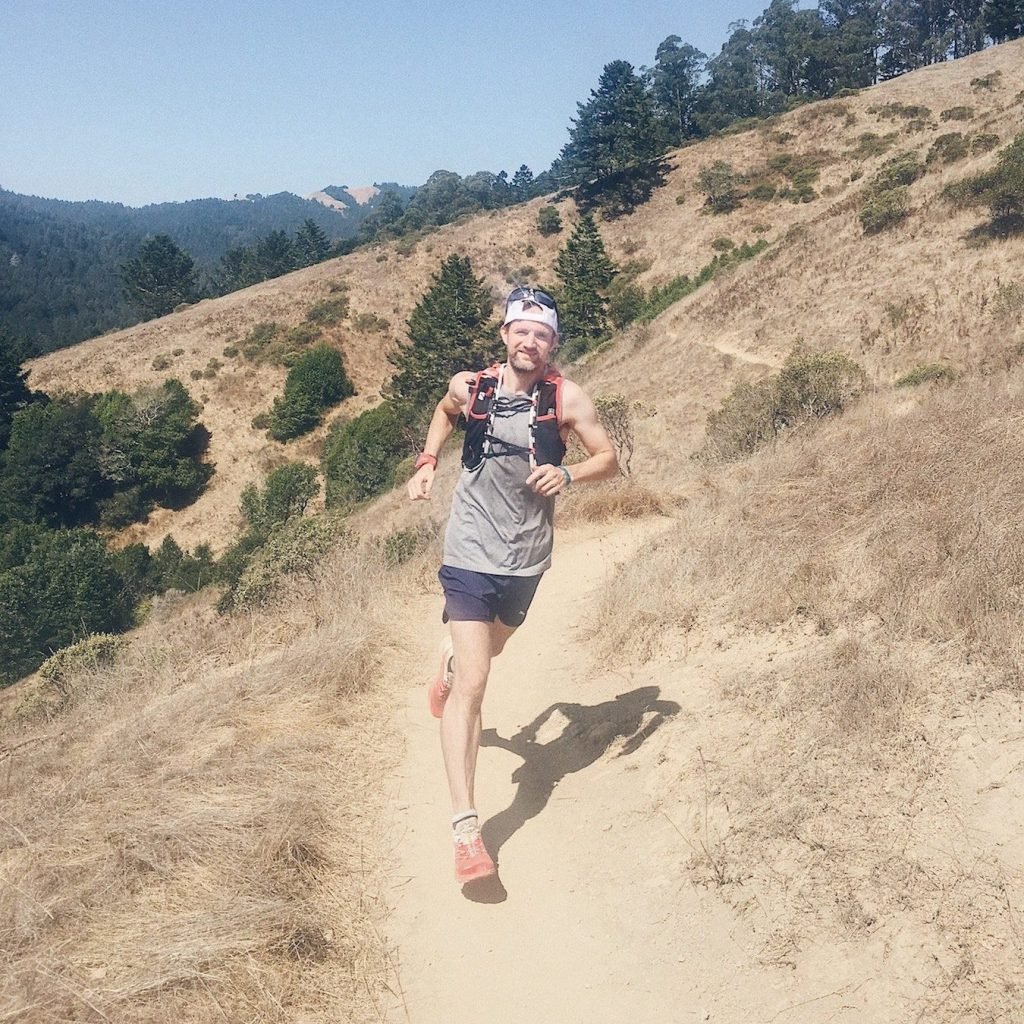
What makes a good running pace on trails is actually an impossible question to answer, because it majorly depends on factors such as your current fitness level, the terrain, weather, altitude, and elevation gain/loss (uphills and downhills) on your run.
It would be much easier to answer this when specifically talking about a trail route that has been run many times – like a popular trail race, for example.
However, compared to road running, we find that on average we run trails around 15-20% slower than we do on roads.
One of the greatest things about this sport is that actually, for many trail runners, it is not about the speed or pace you run at. Much of the time, I run by effort level, meaning, I run by how difficult it FEELS, based on past experience.
On some days I’m feeling like I can run trails much faster than usual, and that can have everything to do with how wet and slippery the ground is underfoot through to how hard I want to push myself on that day, and of course my current fitness levels, the shoes I’m wearing, and the altitude at which I may be training at.
This can be a bit of an adjustment to make when you’re used to monitoring your runs by pace and splits, but trust me, it’s an easy one to make, and very liberating.
How Do You Run Uphill On Trails?
I’ll let you in on a little secret when it comes to a good uphill running technique, known to experienced trail runners all over the world.
If an uphill trail is very long or steep, or you’re running a long overall distance and need to preserve energy, then many of us WALK uphill.
Yes, that’s right, it’s more efficient to adopt what we call a ‘Power-Hike’ than actually trying to run up those hills. Here are our top tips (and benefits) for running/hiking up hills fast.
So if you’re wondering what a good technique is for running uphill quicker than you are currently on your runs, then you really need to learn how to power-hike, rather than run steeper gradients.
A ‘power-hike’ isn’t a casual stroll, it’s a purposeful hike where you look up the hill, lean into the gradient, put a hand on each thigh, and POWER your way uphill with focus and pure grit.
Good power-hikers can run uphill much faster than other people can run up, without ever pushing their heart rate to anaerobic levels, but it takes practice.
How To Trail Run Downhill
If you’re new to the sport then you may think that trail running downhill is the easy part! It’s true, it is usually easier when it comes to cardio intensity, however heading downhill can be hard on your body, for a few reasons:
GRAVITY AND HEIGHT
When running downhill, your cadence, or strides are likely to be longer because you are running faster downhill than on the flats or uphills.
You’re not only running forwards but also down, so the impact on your body is greater by the time your foot hits the floor.
ECCENTRIC (DOWNWARDS) QUAD MUSCLE CONTRACTIONS
We often feel the worst post-downhill run muscle pain in our quadriceps (front of thighs), due to the weight-bearing they have been enduring while also helping you bend your legs.
For these reasons, it’s important to practice by finding local trails to run with hills that you can train on, build up your strength and and also improve your proprioception/balance.
Another way to improve strength and stamina for downhill running when you’re not running is by doing strengthening exercises such as leg squats, lunges, ankle strength, and flexibility work.
It also helps to build up your running distance gradually, a maximum of 10% more distance (or time) each week. Some examples of the exercises you can do are in this video of me using a BOSU.
How To Avoid Falling Over When Trail Running
It’s not unusual to express some concern about the risk of falling over. Some helpful tips to reduce your chances of tripping and falling over when running trails are:
SLOW DOWN – don’t worry or even think about your pace when on more technical trails. It’s more important to allow yourself some time to practice your technique and running form when you are just getting started.
TAKE SMALLER STEPS AND PICK YOUR FEET UP – smaller steps help you keep your center of gravity over your feet, reducing the likelihood of you slipping.
Taking smaller steps rather than large strides also helps reduce impact-related running injuries, as you’re spending less time in the air and so landing on each foot has a smaller impact.
And picking your feet up, especially when tired is an easy way to reduce accidentally kicking rocks or tripping over tree roots, that can existed on even the most groomed trails.
FOCUS – on what you’re doing, in the moment. Look ahead at the terrain, plan where your feet will land and think about how quickly you will make your steps. Losing focus is one of the top reasons new trail runners trip when they start out
Look out for potential hazards such as large obstacles, loose rocks or sticks that might move when you step on them, and other more unusual things such as large wildlife up ahead that you may need to avoid.
Take Plenty Of Water When Running Trails
Always take more water and food than you think you will need.
Even experienced trail runners get caught out without the right gear from time to time, but the goal is to be prepared for the unexpected and reduce the risk of running out of the essentials.
A water bottle and energy gels are good to have, especially if you are planning a long run.
When you run out of water you run the risk of becoming dehydrated and collapsing, which happens surprisingly often on hot summer days even in countries with relatively cool climates.
As well as getting dehydrated if you don’t drink enough water when running, if you don’t take on enough salts/electrolytes then you run the risk of getting muscle cramps.
Muscle cramping can put you off running for a long time afterward unless you know how to overcome them or better yet, know how to prevent muscle cramping.
I’ve been known to go out with the intention of spending a couple of hours, but end up spending almost three hours because it was hotter than I expected, or I just felt like running further.
These situations mean I could spend more time out in the heat.
In case this happens to you, it’s important to have a snack and enough water with you – and also, of course, let someone know you’re ok and that you’re just going to be out running longer than planned.
Our Garmin watches have a great feature that we use called Active Track. It essentially emails a list of contacts of your choosing, your entire route, and displays your progress in real-time as you’re running. If you’re wondering what watch I choose, it’s the Garmin Forerunner 965.
This means your chosen contact(s) don’t have to worry about you getting lost, or getting an injury and no one being able to find you, should you ever find yourself in real trouble.
Sign up for a race – and let that that commitment drive your training motivation
There are so many great trail races around the world (and local to you of course) that you should look into. Whichever trail race you choose, be sure to follow one of our FREE training plans to get you race fit.
Gear Guide: Trail Running Shoes, Apparel, and Running Hydration Packs
If you’re wondering what shoes to wear for trail running, what special clothes may be necessary, and curious to understand what other gear is commonly worn (or used), and why – this is the section for you.
In addition to this beginner’s guide to trail running, we also have plenty of comprehensive, experience-backed buyer’s guides for trail running gear. These gear guides include trail running shoes, hydration packs, trail running poles, GPS Watches, Hats, Sunglasses… and the list goes on.
Trail running gear can be accumulated as you gain experience and develop your love of off-road running, so you don’t have to rush out and buy everything all at once!
Time and experience on the trails will help you work out what accessories you may need, depending on the type of running you enjoy the most, in terms of duration, types of terrain, distance, and the climate you’re in.
Gear Essentials
In order of priority, here are the three top pieces of trail running gear we recommend buying first:
TRAIL RUNNING SHOES – To see our current top recommendations visit our Best Trail Running Shoes buyer’s guide.
A HYDRATION PACK / RACE VEST – We highly rate Salomon when it comes to hydration vests for running, but check out all our favorite ones in our Best Hydration Packs For Running buyer’s guide.
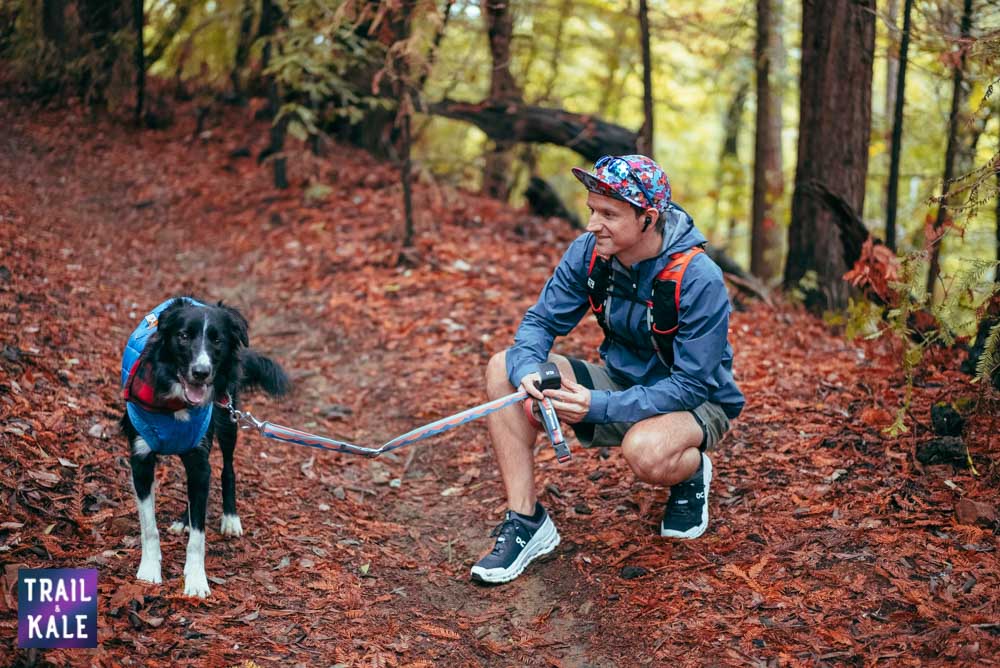
A WATERPROOF JACKET – When running in the mountains, you never really know when the weather may change. And when things go south in the mountains, you need to be prepared for the worst, even if you’re hoping for the best.
A waterproof jacket could be the difference between hypothermia and making it down safely. Read our Best Waterproof Running Jackets buyer’s guide next to find the best one for you.
Do I Really Need Trail Shoes? Are Regular Running Shoes OK?
Some trail shoes are best for wet, soft and muddy ground, as they have large lugs (and therefore better grip in slippy wet conditions) and can be waterproof – but these shoes are not necessarily going to be comfortable or perform well on dry, packed hard dirt trails, or rough rocky mountain trails.
There are other shoe options that are best for those types of trails. Having the right type of trail shoes will help reduce the chance of you falling over due to losing grip.
For your first few runs, you may not need trail running shoes, especially if you choose a relatively flat and even trail, such as a park path, fire road, or bridlepath that doesn’t have many obstacles.
Just like with any new sport, if you’re just getting started then it makes sense to try it out a few times to make sure you love it before you go ahead and spend money on gear.
Having said that, I’m sure you’ll love it, and therefore pretty quickly you’ll want to increase your enjoyment of running trails by having dedicated trail running shoes that can give you the support, grip, and durable features that you can trust when out on adventures.
How To Carry Water And Gear: What Is A Running Hydration Pack?
If you are an experienced road runner who is used to running half marathon distance or longer like a marathon or ultramarathon, but new to going off-road, you may want to immediately start running trails for a couple of hours or more.
If this is the case, once you have a pair of trail running shoes, then consider investing in a running vest (a.k.a. a running hydration pack) or even a running belt for shorter runs.
This type of running backpack is a must-have for long runs, as depending on its volume, you can use the race vest to carry everything you need from a couple of hours up to a full day out on the trails.
A hydration pack (also known as a race vest or a running hydration vest) is pretty much always the answer to questions that are along the lines of ‘how do I take/carry XYZ on my long trail runs?’, and that includes carrying all the water and food you may need to carry with you running.
Other Trail Running Gear For Beginners
Examples of the types of gear you may need to carry with you (and store in your hydration pack) while trail running are a warm layer, waterproof jacket, energy gels, water bottles, phone, keys, running first aid kit, running hat, running poles, gloves.
We recommend a waterproof, breathable jacket designed for running as one of the priority items of clothing.
Waterproof jackets are important because for many people in many climates if you’re subject to wet, windy, and/or cold conditions then wearing, or at least carrying a waterproof jacket with you on your trail runs becomes a necessity to help you stay comfortable and enjoy your time out there without unnecessary exposure to the weather.
RELATED GEAR GUIDES:
- The ultimate trail running gear guide: what to wear trail running
- Best running hydration vests for men and women
- Best waterproof running jackets
- Trail running essentials for emergencies
Trekking poles are not just for hikers and ultra runners
Using hiking poles for trail running is a legitimate and, in steep mountain races, particularly in Europe, encouraged thing to do, whether you are a beginner or seasoned ultramarathon runner. Trail running poles have many benefits, including:
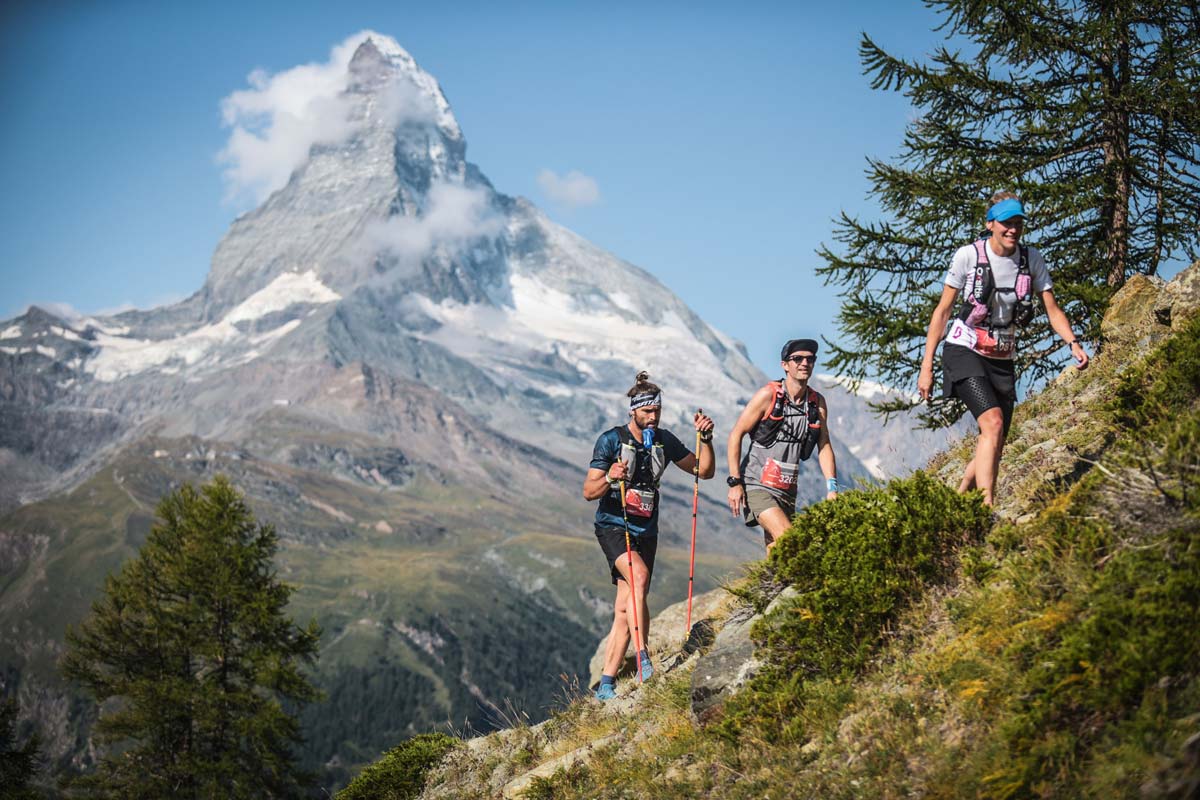
- Making uphill climbs on steep (eg mountainous) trails, easier
- Allowing you to get into a rhythm when climbing uphill
- Helping with balance on steep descents by allowing you to probe for stable ground before committing with your feet.
If you are recovering from a running injury, particularly with parts of your body such as knees and ankles, carrying some lightweight folding running poles with you (just in case), can be a great help.
➡ Read this post next for a more in-depth look at the benefits (and drawbacks) of running with poles, and the best techniques for using them in races.
How To Find Running Trails Near You
So you’ve read our tips in the how-to trail run section above, and everything you need to know about how to start trail running, but the next question you probably have is how to find good local trails to run on.
By the way if there’s something we missed and you still have a question, please feel free to ask me in the comments below – ALWAYS happy to help. 🙂
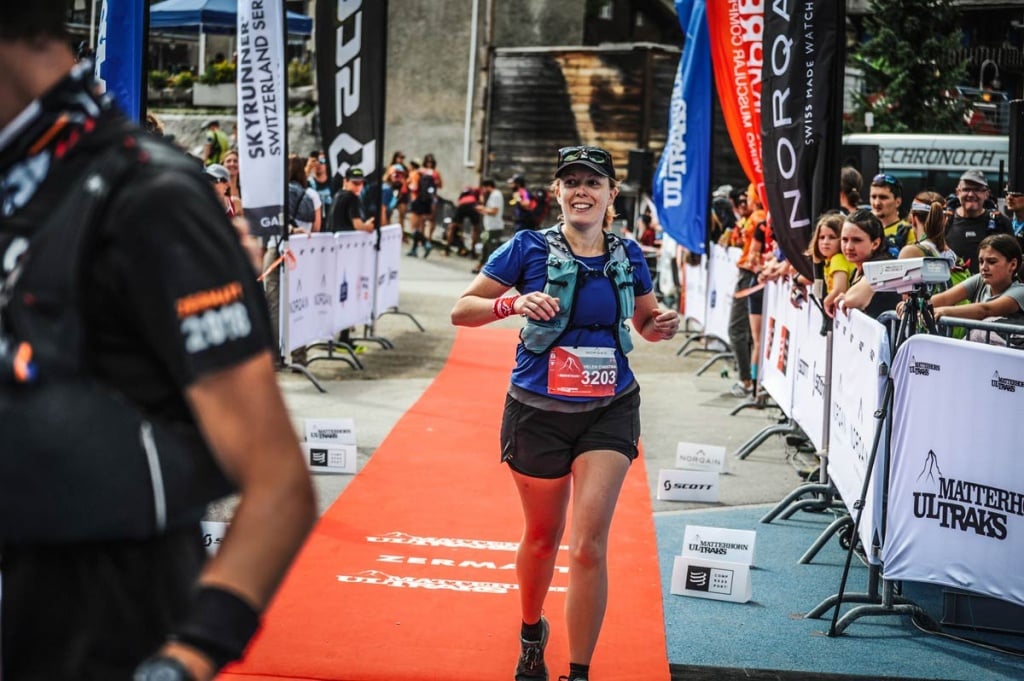
An easy starting point until you get more experience in terms of how to trail run on different types of terrain, ascents and weather conditions is to choose trails in parks with well-marked paths and facilities (toilets, rangers, drinking fountains, cafes).
It can also be fun to sign up for a short local trail race, rather than heading up the most remote mountain or coast path you can find.
By running somewhere that’s easy to get around and not too challenging or remote, this means you can focus on your breathing and movement, rather than being concerned with working out where you are and what direction you need to go.
A local park could also be a helpful place to start if you have not accumulated all the recommended clothes and gear you should carry with you to help keep you safe somewhere remote/exposed or technical in terms of tricky terrain underfoot.
The best ways to find trails to run on by looking them up online are explained in our dedicated post on how to find trails, which is perfect for beginners and experienced trail runners as well as hikers.
As well as using the tips and apps explained in that post, going for a run with other people is another great way to find new trails to run on.
When you are new to the sport it really helps to have other people to support and guide you on your first few runs, or when running in a new place on new trails, in a number of ways:
- Commitment – it’s harder to drop out if you’ve committed to meet someone for a run
- Company – is (hopefully) enjoyable
- Safety – someone is there to look out for you
- Trail know-how – you can learn techniques as you go.
Whether you are an experienced runner or not, another great way to learn new trails is by signing up for a local trail race. Many race organizers offer 5k trail races, through to 10ks, half marathons, marathons and ultramarathons.
Other trail running tips and frequently asked questions
Is Trail Running Dangerous?
Like any sport, it has its risks, and if you go out to run a trail, particularly if you are less experienced, it is important to understand how to stay safe on the trails.
Key steps you can take to do so are to:
- ensure you are well-prepared, with enough water and essentials in the event of a run taking longer than planned (which happens ALL the time)
- know what wildlife encounters you may experience, including the smaller critters like ticks
- know where you are going and how to get back and
- tell someone where you are going and how long it should be before you’re back (or run with other people).
To learn more on this topic read this article: Is trail running dangerous? How to stay safe on the trails.
What every new trail runner needs to know about trail etiquette
In the absence of any ‘formal’ or specific rules relating to the trail you are running on, please exercise common sense, good judgment and we suggest these guidelines to respect the trails and other trail users:
It goes without saying, but I’ll say it anyway: Leave No Trace.
That’s everything from trash (including banana skins), which you should carry out with you, to the output of any emergency bathroom stops, which should be well away from the trail, and ideally buried – with no paper or anything left behind.

Give way to other trail users especially if they’re traveling uphill, and always if they are with horses or on horseback.
While in some places bikers are supposed to give way to pedestrians, it’s often easier to quickly step out of the way and let someone on a mountain bike go past you, than just assuming/expecting them to stop for you (not to mention, safer for both of you).
Run through puddles!
Why? Because it’s fun of course and quicker than going around them. But from a trail etiquette perspective, it’s also better for the trail because if you step around a large puddle, then you’re likely stepping on the side of the trail and making the trail wider.
Remember to enjoy the process, not the end result
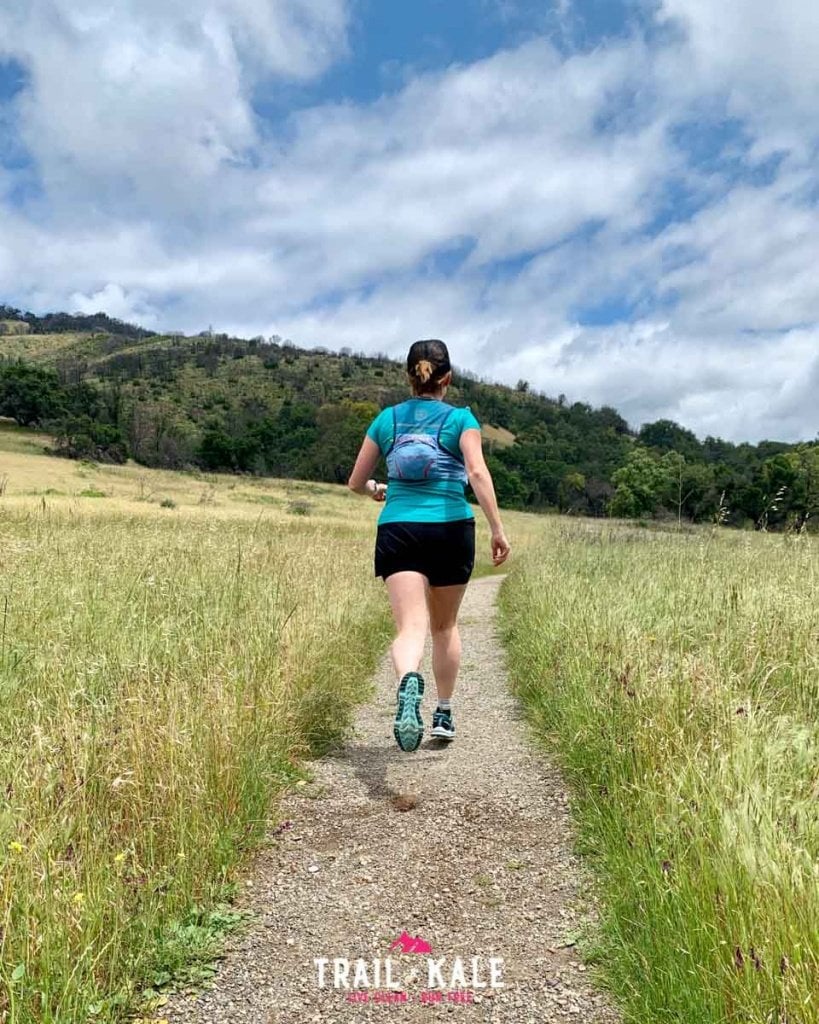
One of the biggest things that trail running teaches you is how to be patient.
When I was new to the sport, I had to learn that climbing a steep uphill is always hard (probably why I enjoy it so much), and it takes time (but it’s worth it when you get to the top… and get to run down the other side).
Trail running can be hard, and it will make you humble – but it’s during the challenges in life where we grow the most.
Sometimes it will be the terrain, other times it will be the climate, and yet other times it will be the sheer magnitude and beauty of nature.
Whatever it is, it’s REAL. It’s not on the internet or in your mind.
Being out and moving in nature, whether it’s your local park, the desert, the forests, or the mountains, makes you feel alive, free, and also really small, which helps with gaining perspective on life’s other challenges and preoccupations.
It’s good to feel humility, and it’s good to exert yourself a bit, get a bit dirty (or very dirty), and breathe fresh air.
It’s also worth having in mind that running a trail race can take you a long time.
Whether it’s two, four, eight or more hours, which requires a lot of self-control to avoid burning out (a.k.a. ‘bonking – for a definition see our running terms glossary), which, in turn, requires you to be patient with yourself and learn to enjoy the journey, rather than just rushing to the end of the run.
Trail races may be longer (or shorter) than the stated distance
Because there is less emphasis on finish times than there is at road running races (unless, of course, you’re looking to win the race or set a new course record), and every race is different due to the varying terrains and elevation/ascent/descent of each course, no two trail races can truly be compared.
This is why it can be amusing to a trail runner if you ask them what their half marathon or marathon time is, or how long it takes to run a 50k.
Ultimately, the time will depend on so many elements and differences between different trail races and even the same race run in different weather conditions.
Given this, and the fact that it is very difficult to accurately measure some trails for distance, a race may be stated as a half-marathon (13.1 miles), but actually, be 12.5 miles or 14 miles. Hey, that’s part of the fun of these races, right?!
I’m telling you this now, so you don’t get shocked (or – gasp – angry!) if you reach 13.2 miles and still can’t see the finish line of your first trail half marathon.
It’s ok, you’ll get to the end soon, just maybe not as soon as you’d thought. Just don’t shout at the race director when you get back to the finish line, it’s not cool (I’ve actually witnessed this on more than one occasion) – don’t be that person, lol 😉
How do you run on trails at night?
If you are new to the sport then I would recommend starting out just running during the day.
Make sure you head out with plenty of time to finish your run in daylight hours! However, night runs can be fun, if you’re well-prepared.
At the very least, you’ll need a good quality headlamp suitable for running with.
We strongly suggest knowing the area you’ll be running in well, or going with someone who does, to reduce the chance of getting lost – as trails can look very different at night.
Also, it goes without saying that having a decent map and compass and/or a GPS watch is something we always recommend when it comes to gear.
Read our in-depth guide to running at night after this post, if you intend to run in the dark.
Can you go trail running with your dog?
Yes! If you have a dog that is fit and healthy enough and of a build suited to running the types of distances you may want to run, then trail running with your dog is an excellent way to spend quality time with your furry friend and both stay fit (assuming the trails you intend to run on allow dogs).
MONITOR YOUR DOG’S FITNESS AND WHEREABOUTS: If you’re interested in tracking your dog’s fitness, including steps, mileage, sleep, intensity minutes, and also need a safety net of GPS tracking should they run off, have a read of our Fi Dog collar review – it’s the smart GPS collar that our dog Kepler uses, and we love it.
Like people, dogs need to build up the mileage and shouldn’t do too much too soon – and puppies shouldn’t do much running until their joints have finished developing, to reduce the risk of long-term injuries resulting from running impacting on growing bodies.
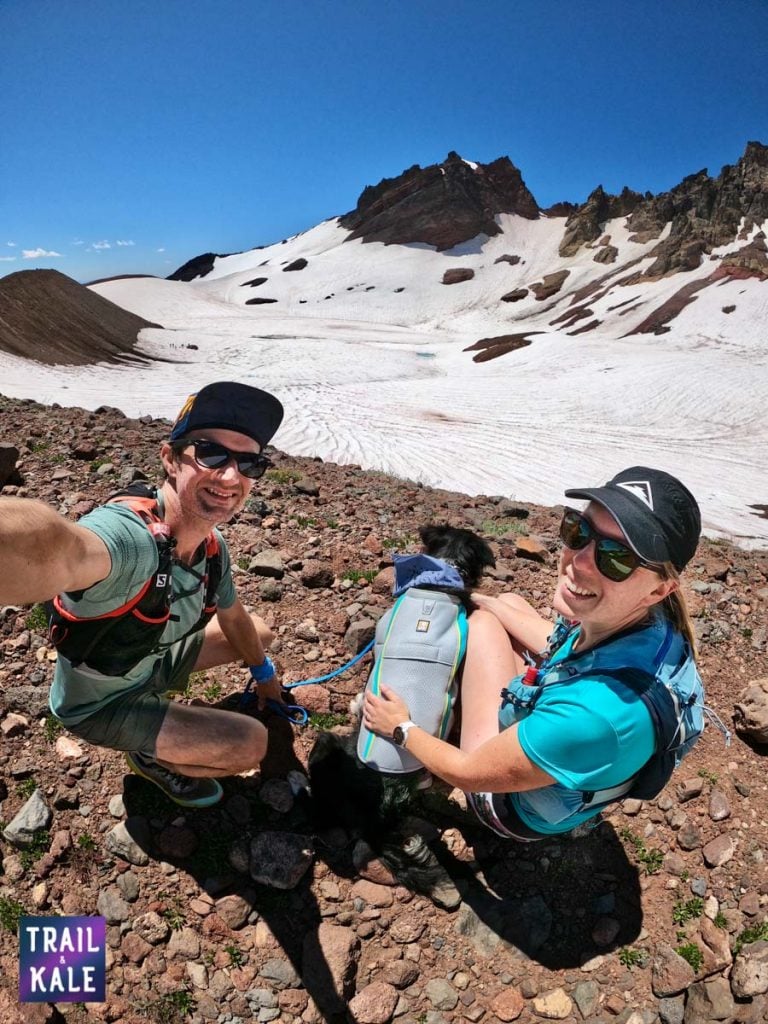
We suggest checking with your vet that your dog is clear to run trails with you.
It’s important to be prepared to look after your dog’s needs during your run, such as carrying enough extra water, food, and an emergency first aid kit for them (you can store it in your hydration pack).
Remember that even if you’re not too hot or thirsty, your dog is unable to sweat and so care and good judgment must be exercised to ensure that you keep them safe, healthy, and protected from risks such as dehydration, heat stroke, hypothermia, exhaustion, and injuries such as cut paws.
If you have a dog or are planning to get a dog and hope to take them on these types of adventures then we also have a load of adventure-dog content featuring our trail dog Kepler.
This content includes posts like ‘how to trail run with your dog‘, ‘how to calm your dog down after exercise‘, and ‘adventure dog gear essentials‘.
Is trail running bad for your knees and ankles?
We are personally of the view that running, in general, is not bad for your knees and ankles, if you do not over-train or build up your time and mileage quicker than your body is trained for.
Of course, everyone is different and has their own physical ability and we all start from a different point in terms of strength, flexibility, weight, balance, and level of conditioning through other sports.
Running is a very natural thing for people to do – we did, after all, evolve with a physique that is designed to be capable of long-distance endurance running. We are all born to run.
Having said this, I experienced significantly more training injuries when running predominantly on roads (pavement/tarmac/concrete) than I do now I choose off-road running over hard surfaces, even though I run significantly greater distances than I used to.
Part of this is because I have more training under my belt, and my body is more efficient at running in terms of my form.
Part of it is no doubt because trails are generally softer surfaces, less repetitive in terms of impact on your feet/ankles/knees/body in general, because no two footsteps really land the same, and you have to vary your stride length to move effectively around uneven terrain.
If you are new to trail running, one of the biggest tips I can share is to take it easy on your first few runs.
Like when you do any sport for the first time, you may be surprised, even if you are already a runner, by how tiring it can be when you work your body’s muscles differently on off-road terrain.
The last thing you want is to be getting an injury like back pain while running due to you overworking your body too early in your trail running journey – without first improving your form and trail fitness.
For more background on why we were ‘Born to Run’, have a read of this fantastic running book, that will change the way you think about our bodies and our capabilities as far as endurance running is concerned. Here are more great running books worth reading.
Here are 5 Ways to Improve Running Form and Prevent Injuries – a topic that we wrote about to help others benefit from injury-free running too.
Glossary of Trail Running Terms
The trail running world is full of jargon, like most sports, so if you’ve come across some words or abbreviations and are curious about what they mean then you can probably find them in our running terms glossary.
Trail Running For Beginners – In Summary
We hope you have found this ultimate guide on how to start trail running helpful and that it has given you the trail running tips and advice you were looking for if you’re new to trail running.
If you still have questions about how to trail run then drop us a comment below!
For more tips, gear guides, and inspiration, stick around to read more! You can also connect with us on Instagram and don’t forget to check out our YouTube channel for running short films, trail running tips, and reviews of trail running shoes and other gear.
